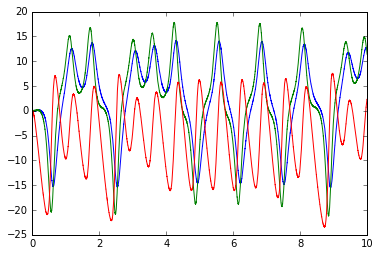Lorenz Attractor example¶
The Lorenz chaotic attractor
This example shows the construction of a classic chaotic dynamical system: the Lorenz "butterfly" attractor. The equations are:
$$ \dot{x}_0 = \sigma(x_1 - x_0) \\\ \dot{x}_1 = x_0 (\rho - x_2) - x_1 \\\ \dot{x}_2 = x_0 x_1 - \beta x_2 $$
Since $x_2$ is centered around approximately $\rho$, and since NEF ensembles are usually optimized to represent values within a certain radius of the origin, we substitute $x_2' = x_2 - \rho$, giving these equations: $$ \dot{x}_0 = \sigma(x_1 - x_0) \\\ \dot{x}_1 = - x_0 x_2' - x_1\\\ \dot{x}_2' = x_0 x_1 - \beta (x_2' + \rho) - \rho $$
For more information, see http://compneuro.uwaterloo.ca/publications/eliasmith2005b.html "Chris Eliasmith. A unified approach to building and controlling spiking attractor networks. Neural computation, 7(6):1276-1314, 2005."
import matplotlib.pyplot as plt
%matplotlib inline
import nengo
%load_ext nengo.ipynb
tau = 0.1
sigma = 10
beta = 8.0/3
rho = 28
def feedback(x):
dx0 = -sigma * x[0] + sigma * x[1]
dx1 = -x[0] * x[2] - x[1]
dx2 = x[0] * x[1] - beta * (x[2] + rho) - rho
return [dx0 * tau + x[0],
dx1 * tau + x[1],
dx2 * tau + x[2]]
model = nengo.Network(label='Lorenz attractor')
with model:
state = nengo.Ensemble(2000, 3, radius=60)
nengo.Connection(state, state, function=feedback, synapse=tau)
state_probe = nengo.Probe(state, synapse=tau)
with nengo.Simulator(model) as sim:
sim.run(10)
from mpl_toolkits.mplot3d import Axes3D
ax = plt.figure().add_subplot(111, projection='3d')
ax.plot(sim.data[state_probe][:, 0],
sim.data[state_probe][:, 1],
sim.data[state_probe][:, 2])
plt.figure()
plt.plot(sim.trange(), sim.data[state_probe])
Download lorenz_attractor as an IPython notebook or Python script.

